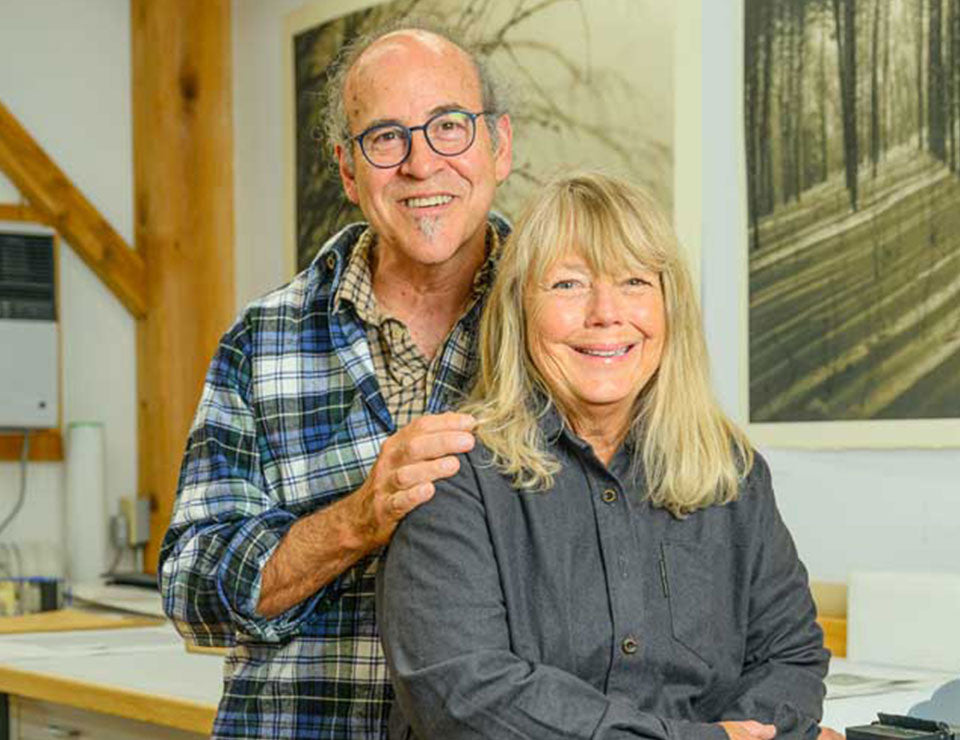If you’ve ever seen a high-quality art print, it’s likely that somewhere in the chain of creation, you have Jon and Cathy Cone to thank. The couple met in college, in the darkroom at Ohio University School of Art, and by their early 20s, they had set up their first print studio in New York’s Soho.
“In the 1980s, the print world was just screaming,” Jon recalled.
“You could go to college and get a degree and find a job,” Cathy added. “That's very difficult, now.”
“That's what we were able to do,” Jon said. “So, we started our own printmaking studio.”

They were making fine art prints for artists and for galleries, and they had several artists who lived up in Vermont. “They would have us bring their prints back and forth, and we fell in love with Vermont,” Cathy said. “It was an easy thing to leave New York City, that’s for sure,” Jon added.
Around the same time, the shift to digital printing was just starting, and the Cones quickly positioned themselves as leaders in the industry, in effect inventing and perfecting fine black-and-white photographic inkjet printing (which they named Piezography). They were the first to do digital printmaking because they coded the software for top-end printers, developed pathbreaking printing inks and technologies, and turned their studio, Cone Editions Press, in East Topsham into the go-to place for photographers, artists, or museums to output their work, or to up their game.

The Cones also offers regular classes in all aspects of printmaking, whether digital or an analog-style printing with palladium or platinum. And they are big believers in sharing what they know so that the industry improves: “We've always shared our technology,” Jon said. “And built companies around sharing our technology.” As a result, they are one of the longest continually operating printmaking studios in America.
“Jon used to say,” Cathy added, “that he took technology and did something really funky with it. But when people come here to work, it's because we have an amazing staff and we've had an incredible lineage of people who've contributed. And the idea is to make the best print you can make.”

Indeed. And the Cones can print on just about any substrate and paper – they even once printed on some handmade paper by one of the world’s greatest papermakers. Each sheet cost $5000.
The client told Jon: “‘I want you to fail.’ This is what he said to me,” Jon recalled. “‘I want you to fail and fail and fail and fail. And so that when you finally get it, you know, it's something.’ And so that's like the ideal client.”
People come to one- or two-week workshops in East Topsham from all over the world. And they have all skill levels, “from first-time hobbyists to super pros,” Cathy said. “Like, there's not a judgment about that. If somebody comes and, you know, it's like, um–”
“We're a democracy, an art democracy,” Jon chimed in, laughing.

They have invented too many things to mention, too many technologies to understand, but all of them focused on pushing the world of printmaking forward. And the unique, high-end inks they have invented, which are unparalleled for being able to reproduce gradations and shades of black like no other, are also made in Vermont, with one eye always on sustainability.
“I think there's two ways you can make something,” Jon said when asked to reflect on what makes a maker. “You make something that fits what current needs are. Okay. But then you're competing with a bunch of other makers. But if you can envision something that you think people will want or need and make those things, then you invent your own market, so to speak. And that's what we've done, always. And that's why we've been able to be address-independent. So, when I think about what we might end up doing or making or offering to people, I don't think of something that exists already… You have to be adventurous and be willing to risk and lose and, and all those various things. But if you believe in something and you make it, they will come. It's like that Field of Dreams story… So we've always done that. And as a result, we don't have to do any market research, because there's no market there already.”
Cathy, who is also an artist, added that “making art is sort of like listening to your heartsong and then practicing like hell to sing it. And it's in that making that you get to step out of it, and look at it as someone who's not in it, the maker... These things we practice and make are… guidance about what's the next thing, you know? And it's always ahead of us and we're trying to catch up…”

The Vermont Maker Project
Telling stories about makers across the state of Vermont. Stories and photos by StoryWorkz. Flannel by Vermont Flannel. Learn more at vermontmakerproject.com.

